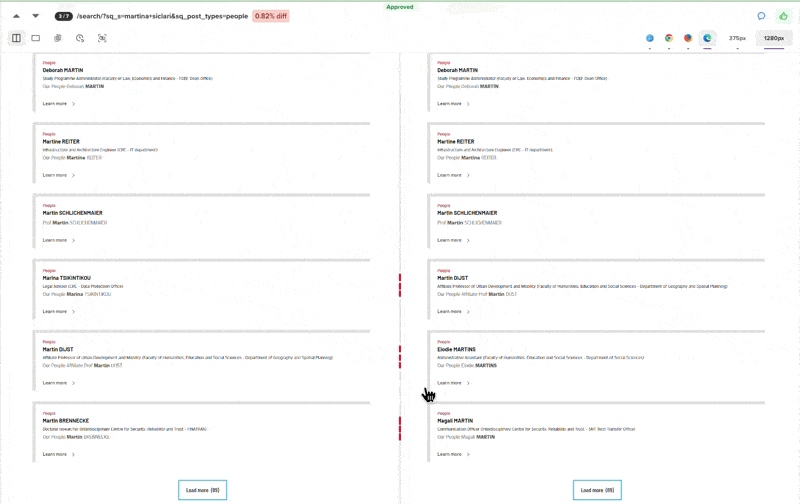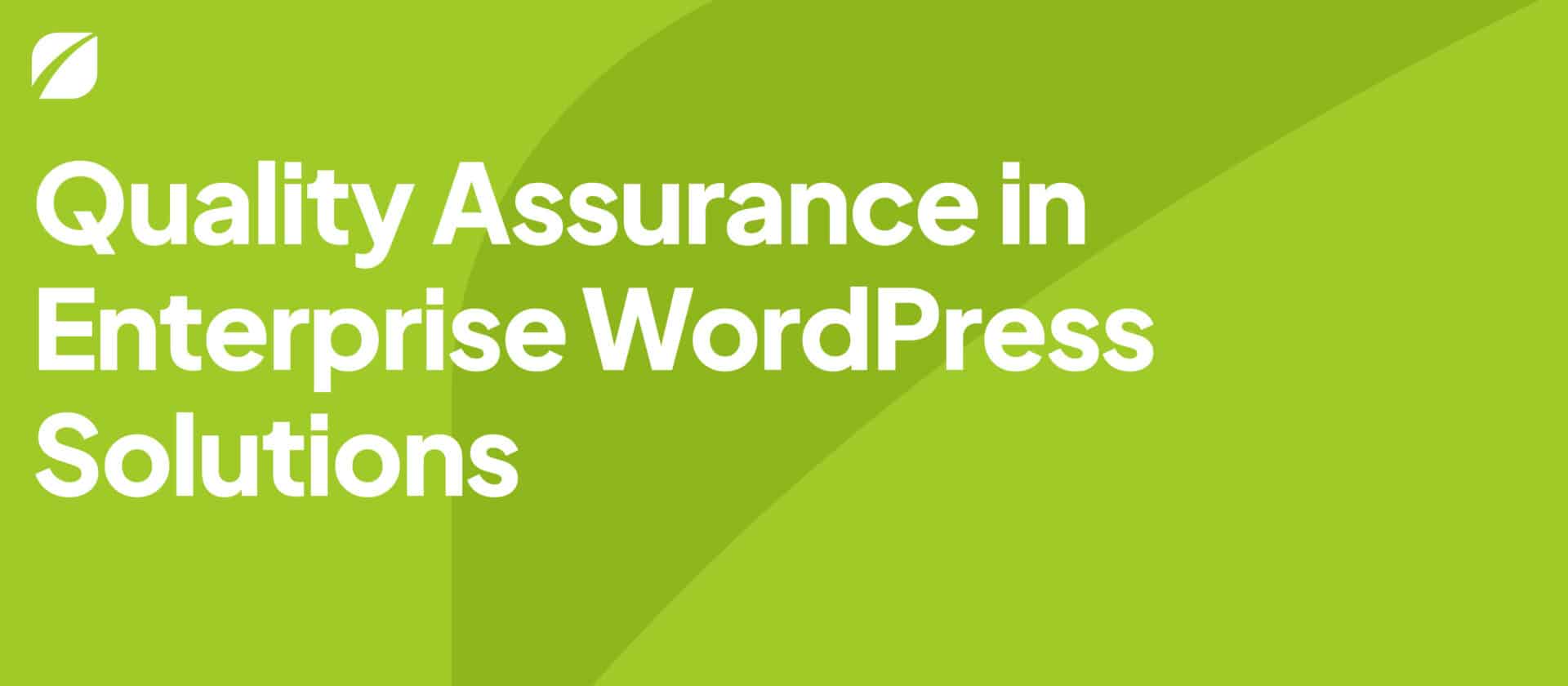As web development has evolved, so has the need for Quality Assurance (QA). With more and more interactions between organizations and their audience happening online, the importance of website QA has grown too. In the last decade, quality assurance has matured as an engineering discipline and, as a result, has a vital role in web development processes.
This is especially true for enterprise-level applications: large organizations often have unique requirements and a need for scalability that cannot be met by using existing solutions. Custom development is often needed for increased scalability, the implementation of complex features and integrations with third-party services. For an enterprise-grade WordPress application, this comes down to the development, maintenance and continuous improvement of custom plugins and themes. With enterprise sites often handling large amounts of traffic and their essential business depending on the reliability of the software, it’s clear that comprehensive QA and thorough testing is essential.
Key benefits of quality assurance in enterprise web development
Quality assurance plays a pivotal role in enterprise web development. In this article, we will take a closer look at the following key benefits:
- Ensuring reliability and stability
- Building trust with organizations and their audience
- Faster time-to-market
- Maximizing Return on Investment (ROI) and cost efficiency
- Compliance and security
- Future-proofing and scalability
- Embracing the QA mindset
It’s a long list, so let’s just get started!
1. Ensuring reliability and stability
Large-scale websites must handle heavy traffic, complex features, and integrations with various third-party systems. Any instability can lead to downtime, lost revenue, and damage to the company’s reputation. Manual and automated QA processes ensure that web applications are thoroughly tested for performance, security, and functionality before they go live. By identifying and resolving issues early, QA helps prevent costly post-launch problems, ensuring a reliable and stable website that meets business and user needs.
2. Building trust with organizations and their audience
Introducing QA to web development processes helps build trust twice – in two different ways. First, quality assurance can ensure that the final product is not only functional but also user-friendly, accessible, and aligned with the organization’s brand and business goals. This helps the organization build trust with their audience – customers, users or other visitors of the site.
Secondly, quality assurance specialists need to be keenly aware of the business goals, needs and expectations of the client organization. Working closely with stakeholders from the organization and the developers building the solution, QA specialists are uniquely positioned to ensure that the end product is exactly what was envisioned. At Syde we have found that with their attention to detail, QA specialists help build trust between us and our clients, leading to long-term partnerships and further collaboration.

3. Faster time-to-market
Nobody likes to wait for a new feature to land. But it’s even worse when a new feature is deployed with a critical issue that was missed during development. Complex projects almost always benefit from automated testing and regression testing which can be integrated into the development processes by QA engineers.
Once these automated QA processes are set up, they speed up feature development by catching and fixing issues early, reducing rework, and minimizing last-minute delays. A thorough and efficient QA process allows companies to bring their WordPress solutions to market faster without compromising on quality.
4. Maximizing Return on Investment (ROI) and cost efficiency
Quality assurance helps maximize ROI by ensuring the final product is free of major issues that could require costly fixes later on. Additionally, delivering a high-quality product that meets or exceeds client expectations also boosts sales, customer retention, and brand reputation.
A common misconception is that QA adds unnecessary costs to a project. In reality, investing in QA early can lead to significant cost savings over time. At Syde, we promote the concept of “shifting left”: QA specialists can often help identify where requirements are unclear or incomplete. This helps the organization to hone in on their specific needs and ensures that developers do not spend time implementing the wrong features or business logic.
Then, by identifying and fixing issues before they become major problems, QA prevents expensive post-launch fixes and reduces the need for extensive support. A well-tested website is far less likely to suffer from issues that could lead to lost revenue or increased operational costs.

5. Compliance and security
For enterprise companies operating globally, following industry standards and regulations is a must. Whether it’s data privacy laws, accessibility standards, or industry-specific rules, failing to comply can result in hefty fines and legal issues. QA engineers can implement tailored tests to ensure that a website is compliant with national or international regulations.
A good example is the European Accessibility Act, coming into effect in 2025. While it should be said that addressing accessibility goes beyond code, we strongly recommend organizations to run accessibility tests to learn how their websites and online services can be made fully accessible to everyone. Implementing QA processes for accessibility leads to a win-win situation: it helps organizations with compliance and improves the overall user experience for their audience.
6. Future-proofing and scalability
As businesses grow, their websites need to scale and adapt to new demands. Enterprise websites generally already have high visitor counts, with traffic surges after important press releases or product launches. A good hosting partner can help mitigate some of the risks of downtime during surges, but it is equally important to strengthen and future-proof WordPress solutions by building features on a solid foundation that can be easily updated and scaled as needed.
QA plays a crucial role in achieving these two types of scalability. Syde engineers are strongly focused on code quality and industry standards, and they rely on unit and integration testing to ensure that their software is reliable and meets industry coding standards. Our QA engineers can add load and performance testing to that mix, ensuring that the website can grow alongside the business without major issues.
7. Embracing the QA mindset
Last but definitely not least, a successful project embraces the different mindsets of engineering disciplines and encourages them to complement each other’s strengths. Without wanting to generalize too much, it is safe to say that developers often focus on building and innovating, aiming to create functional and efficient solutions. They are problem-solvers who think in terms of possibilities and solutions. On the other hand, QA professionals approach the software from a different angle, often described as a “destructive” mindset. This doesn’t mean they aim to break the product, but rather, they rigorously test it, searching for vulnerabilities, bugs, and potential issues. Their job is to think of all the ways the software could fail and ensure these issues are fixed before the product reaches users.
This difference in mindsets is crucial for creating a high-quality product, especially in the enterprise world. While developers focus on creating the best possible solution, QA professionals ensure that it is reliable and meets all requirements. When these two mindsets collaborate, the result is a more polished final product.

Best Practices for implementing QA in enterprise WordPress solutions
WordPress has evolved from a popular blogging platform to a powerful, scalable CMS that can handle enterprise-grade websites with complex requirements. Its flexibility makes it ideal for enterprises, enabling them to create highly customized digital experiences. Major organizations like Microsoft, The New York Times, and even the White House use WordPress to meet their unique needs, showcasing its ability to support enterprise-level demands.
To fully benefit from QA in enterprise WordPress projects, it’s important to follow industry best practices. Here are some key guidelines:
- Integrate QA early and often: Involve QA professionals from the beginning, including during planning and design, to identify potential risks and set quality benchmarks.
- Automate testing: Automated testing is essential, especially for large projects. Automated tests can quickly and repeatedly validate that the code is functioning as expected, reducing the manual effort required for repetitive tasks and catching regressions early.
- Ensure cross-browser and cross-device compatibility: Test the website across various browsers and devices to ensure it functions consistently and displays properly.
- Focus on performance and load testing: Ensure the website can handle high traffic and complex interactions without degrading user experience.
- Conduct security testing: include rigorous security testing to identify vulnerabilities and protect against common threats.
- Prioritize accessibility testing: Ensure the website is accessible to all users, including those with disabilities, to create an inclusive digital experience.
- Create comprehensive test plans: A well-structured test plan guides the QA process and ensures all aspects of the website are thoroughly tested.
- Implement continuous integration and continuous delivery (CI/CD): Integrate QA into the CI/CD pipeline to benefit from automated testing at every stage of development, ensuring code quality.
- Maintain clear communication and documentation: keep clear communication with all stakeholders and document test cases, results, and known issues for future reference.
Conclusion
Quality assurance is more than a buzzword; it’s a necessity. By embracing the QA mindset, integrating quality assurance early, automating testing, focusing on performance, and prioritizing security and accessibility, companies can deliver high-quality websites that meet business and user needs.
All in all, QA brings immense value to enterprise companies, helping them deliver reliable and scalable WordPress solutions that meet the demands of their business and clients. Investing in QA ensures faster time to market, cost efficiency, and long-term success in the digital landscape.
